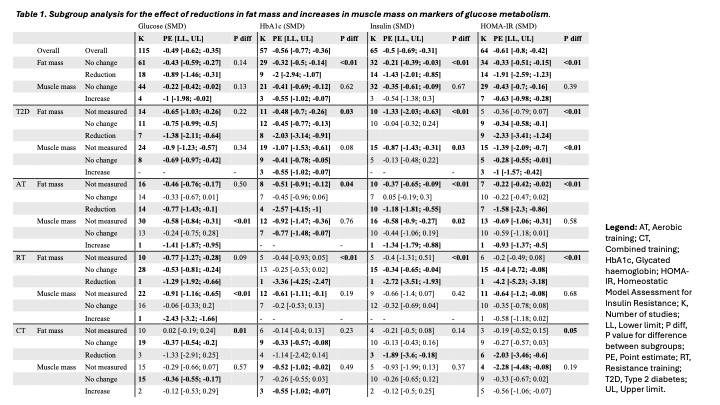Introduction and aims:
Human ageing is associated with increases in fat mass and reductions in muscle mass which impair glucose metabolism, eventually leading to Type 2 Diabetes (T2D).(1) Many studies have hypothesised that body composition may explain exercise-induced improvements in glucose metabolism.(2) We comprehensively integrated the findings of the literature, via subgroup meta-analyses, considering confounding factors such as the presence of T2D and the type of exercise.
Methods:
A search was performed on PubMed, Embase, Scopus, Web of Science, Cochrane Library, and EBSCOhost on 5/8/2024. A systematic review looked for exercise-controlled trials in older adults assessing body composition (fat mass and muscle mass) and glucose metabolism (fasting glucose, fasting insulin, glycated haemoglobin [HbA1c], Homeostatic Model Assessment for Insulin Resistance [HOMA-IR]). Screening, data extraction, and quality assessment were performed by two independent reviewers. We compared the randomized effects of studies that improved and did not improve body composition with exercise training on glucose metabolism, via subgroup meta-analysis (Q-test) on Biostat’s Comprehensive Meta-Analysis.
Results:
301 standardised mean differences (SMDs) from included study arms were clustered. Table 1 illustrates that most subgroups (with improvement in body composition or not) showed improvements in markers of glucose metabolism. Subgroups reducing fat mass underwent significantly greater (p<0.001) improvements in fasting insulin, HOMA-IR, and HbA1c, but not in fasting glucose (p=0.14). On the other hand, the increase in muscle mass was not associated with improvements in any glucose metabolism markers. T2D trials led to higher improvements in fasting glucose, HOMA-IR, and HbA1c, but not fasting insulin, whilst the improvements in glucose metabolism markers were similar between the types of exercise (data not shown).
We tested the influence of body composition within subgroups stratified by diabetes status and training type (Table 1). Within T2D trials, a reduction in fat mass was not necessary to lead to improvements in glucose, HbA1c, and HOMA-IR (insufficient studies testing insulin). Although few T2D trials significantly increased muscle mass, we observed that reductions in HOMA-IR and HbA1c were not dependent on this change.
Within aerobic training (AT), only cohorts reducing fat mass, improved glucose, insulin, and HOMA-IR, but fat mass reduction was not required for reduction in HbA1c. However, improvements in glucose metabolism markers were not dependent on fat mass reduction within resistance training (RT) and combined training (CT) cohorts. The low number of trials improving muscle mass prevented a conclusive analysis.
Conclusions:
Although improvements in glucose metabolism are not fully dependent on changes in body composition, reductions in fat mass make a significant contribution to exercise-induced improvements in glucose metabolism. Only metabolic improvements generated by AT were fully dependent on fat reduction. A limited number of trials increasing muscle mass (particularly within T2D) with overall improvements in glucose metabolism, suggests the increase in muscle mass was not a necessary adaptation to improve glucose metabolism. Future studies should explore the mechanisms by which RT improves glucose metabolism. A limitation of these cross-sectional associations is that we cannot prove a cause-and-effect relationship, and thus, glucose metabolism adaptations may also be mediating body composition.

